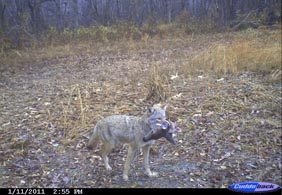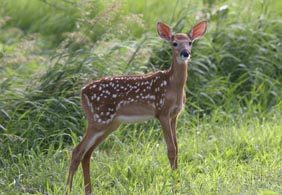Coyote Impacts on Fawn Survival: What’s the Latest?

Our staff attended the annual Southeast Deer Study Group meeting back in February 2012 and the theme revolved around how predators are changing the way deer populations are managed in some areas across the Southeast. We are still learning about the behavior and general ecology of coyotes and their impacts on wildlife species. White-tailed deer have evolved with large carnivores across most their range for centuries, but the rapid eastward movement of coyotes has presented some unique challenges to deer managers at the landscape level. Ongoing research studies are assessing the impacts coyotes are having on fawn survival. Unfortunately, most of the results so far do not paint a positive picture.
In a five year study in South Carolina, 178 fawns were captured and fitted with GPS tracking collars to monitor survival. The overall mortality rate for these fawns was 77% and coyote predation accounted for around 60% of the annual fawn crop. The majority of deaths occurred in the first week after birth. Other studies investigating the effects of intensive predator removal on fawn recruitment have shown increases in fawn survival the summer following removal. However, trapping costs ranged from $200-$300/day, and the results were usually temporary (one year). Also, there may be legal issues in some areas prohibiting trapping during the fawning season.
Great variation has been found in coyote movements and behavior. In many cases, once individual coyotes are removed, they are replaced by others occupying adjacent territories. It was thought that creating more early successional habitat (dense vegetation at ground level) would favor small mammals and other alternative food sources, which may buffer coyote impacts on fawn survival due to increased concealment cover. This has not proven to be the case on some of the properties where this practice has been examined. Studies are showing that coyotes shift their diets almost exclusively to fawns during the fawning season supporting the theory that coyotes key on the most profitable prey choice.

So now that coyotes are here to stay, how do we deal with them? In areas of high deer density, coyotes may actually help regulate deer populations and keep them in balance with habitat conditions. Moving forward there will be an increased emphasis on hunters collecting accurate data, both lactation and observation. Based on observation data collected by clubs, it is evident fawns are not being recorded properly (or in some cases not at all). Accurate data will give us a better picture of actual herd conditions and help make management decisions on a landscape level. In an effort to help offset any impacts coyotes may be having on deer numbers, we will be reducing doe harvest recommendations on some properties, based on harvest history, management strategies of neighboring properties, and lactation data. Please help us make informative management decisions by collecting and recording accurate data.

